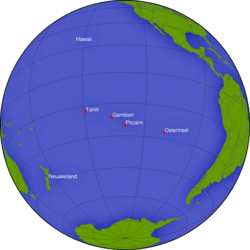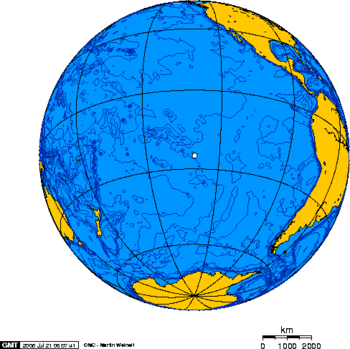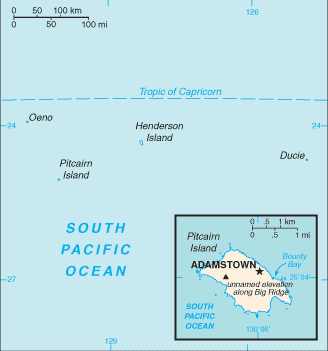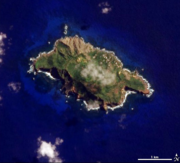Pitcairn Islands
2007 Schools Wikipedia Selection. Related subjects: Geography of Oceania (Australasia)
| Pitkern Ailen Pitcairn Islands |
|||||
|
|||||
| Anthem: " Come ye Blessed" | |||||
| Capital (and largest city) |
Adamstown | ||||
| Official languages | English, Pitkern | ||||
|---|---|---|---|---|---|
| Government | |||||
| - Mayor | Jay Warren | ||||
| - Governor | George Fergusson | ||||
| Area | |||||
| - Total | 5 km² km² sq mi |
||||
| Population | |||||
| - 2005 estimate | 67 ( 230th) | ||||
| - Density | 13/km² ( 197th) /sq mi |
||||
| Currency | New Zealand dollar ( NZD) |
||||
| Time zone | ( UTC-8) | ||||
| Internet TLD | .pn | ||||
| Calling code | +64 | ||||
The Pitcairn Islands (Pitkern : Pitkern Ailen), officially named the Pitcairn, Henderson, Ducie, and Oeno Islands, are a group of four islands in the southern Pacific Ocean. The islands are a British overseas territory (formerly British colony), the last remaining in the Pacific. Only Pitcairn Island — the second largest — is inhabited.
The islands are best known for being the home of the descendants of the Bounty mutineers and the Tahitians who accompanied them, an event retold in numerous books and films. This story is still apparent in the surnames of many of the islanders. With only about fifty inhabitants (from nine families), Pitcairn is also notable for being the least populated jurisdiction in the world (although it is not a sovereign nation). The United Nations Committee on Decolonisation includes the Pitcairn Islands on the United Nations list of Non-Self-Governing Territories.
History
The original settlers of the Pitcairn Islands (Ducie, Henderson, Oeno and Pitcairn) were Polynesians who appear to have lived on Pitcairn and Henderson for several centuries. However, although archaeologists believe that Polynesians were living on Pitcairn as late as the 15th century, the islands were uninhabited when they were discovered by Europeans.
Ducie and Henderson Islands are believed to have been discovered by Europeans on 26 January 1606 by Portuguese sailor Pedro Fernandez de Quiros, who named them La Encarnación and San Juan Bautista respectively. However, some sources express doubt about exactly which of the islands were visited and named by Quiros, suggesting that Quiros’ La Encarnación may actually have been Henderson Island, and San Juan Bautista may have been Pitcairn Island.
Ducie Island was rediscovered in 1791 by the British Capt. Edwards aboard H.M.S. Pandora, and named after Baron Francis Ducie, a captain in the Royal Navy. It was annexed by Britain on 19 December 1902, and in 1938 it was formally incorporated into Pitcairn to become part of a single administrative district (the "Pitcairn Group of Islands").
Henderson Island was rediscovered on 17 January 1819 by British Capt. Henderson of the British East India Company ship Hercules. On the 2 March 1819, Captain Henry King, sailing aboard the Elizabeth, landed on the island to find the King's colours already flying. His crew scratched the name of their ship into a tree and for some years the island's name was Elizabeth or Henderson interchangeably. Henderson Island was annexed by Britain and incorporated into Pitcairn in 1938.
Oeno Island was discovered on the 26 January 1824 by U.S. Captain George Worth aboard the whaler Oeno. On the 10th July 1902 Oeno was annexed by Britain. It was incorporated into Pitcairn in 1938.
Pitcairn Island itself was discovered on July 3, 1767 by the crew of the British sloop HMS Swallow, commanded by Captain Philip Carteret (though according to some it had perhaps been visited by Quiros in 1606). It was named after Midshipman Robert Pitcairn, a fifteen-year-old crewmember who was the first to sight the island. (Pitcairn was the son of British Marine Officer John Pitcairn, who was second in command of British forces stationed in Massachusetts during the American Revolutionary War and was fatally wounded in one of the defining battles of that war, the Battle of Bunker Hill.)
In 1790, the mutineers of HMAV Bounty and their Tahitian companions, some of whom may have been kidnapped from Tahiti, settled on Pitcairn Island and set fire to the Bounty. The wreck is still visible underwater in Bounty Bay. The ship itself was discovered in 1957 by National Geographic explorer Luis Marden. Although the settlers were able to survive by farming and fishing, the initial period of settlement was marked by serious tensions among the settlers. Alcoholism, murder, disease and other ills took the lives of most mutineers and Tahitian men. John Adams and Ned Young turned to the Scriptures using the ship's Bible as their guide for a new and peaceful society. Young eventually died of an asthmatic infection. The Pitcairners also converted to Christianity; however they would later convert from their existing form of Christianity to Adventism after a successful Adventist mission in the 1890s. When the American sailing ship Topaz found Pitcairn again, John Adams was granted amnesty for his mutiny.
The island became a British colony in 1838. By the mid-1850s the Pitcairn community was outgrowing the island and its leaders appealed to the British government for assistance. They were offered Norfolk Island and on 3 May 1856, the entire community of 193 people set sail for Norfolk on board the Morayshire, arriving on 8 June after a miserable five-week trip. But after eighteen months on Norfolk, seventeen of the Pitcairners returned to their home island; five years later another twenty-seven did the same.
Since a population peak of 233 in 1937, the island has been suffering from emigration, primarily to New Zealand, leaving some fifty people living on Pitcairn.
There are allegations of a long history and tradition of sexual abuse of girls as young as 7, which culminated in 2004 in the charging of seven men living on Pitcairn, and another six now living abroad, with sex-related offences, including rape. On October 25, 2004, six men were convicted, including Steve Christian, the island's mayor at the time. See Pitcairn rape trial of 2004. The British government has decided to set up a prison for only the island, and spend an annual budget of $950,000, after the six men lost their final appeal.
Politics
The Governor of the Pitcairn Islands is the British High Commissioner to New Zealand, currently George Fergusson. He maintains a representative officer on the island as a link between himself and the islanders - this is probably the most remote and inaccessible diplomatic posting in the world. But because the high commissioner does not live on the island, its daily affairs were traditionally taken care of by the magistrate, chairman of the Island Council. Elections for this position take place every three years. After a constitutional revision in 1998, these functions were transferred to the mayor of Pitcairn from 1999 onwards. Island Magistrate is a governor appointed job. Chairman of the Internal Committee is an elected official. Until 30 October 2004, the mayor was Steve Christian; after his rape conviction on October 24, 2004, Christian was dismissed (after refusing to resign). Brenda Christian was selected by the Island Council, to be mayor for November and December 2004, until an election was held. Jay Warren was elected on December 15, 2004.
Geography
The Pitcairn Islands form the southeasternmost extension of the geological archipelago of the Tuamotus of French Polynesia, and consist of four islands: Pitcairn Island, Oeno Island (atoll with 5 islets), Henderson Island and Ducie Island (atoll with 4 islets).
The only permanently inhabited island, Pitcairn, is accessible only by boat through Bounty Bay.
Henderson Island, covering about 67% of the territory's total land area, and supporting a rich variety of animals in its nearly inaccessible interior, is also capable of supporting a small human population, but it is hard to get there and back, its outer shores being comprised of uniformly steep limestone cliffs of sharp coral.
The other islands are at a distance of more than 100 km and are not habitable.
| Island/Atoll | Type | Land Area (km²)* |
Total Area (km²) |
Pop. Dec.2005 |
Coordinates |
|---|---|---|---|---|---|
| Ducie Island | Atoll | 0.7 | 3.9* | - | |
| Henderson Island | uplifted coral island | 37.3 | 37.3 | - | |
| Oeno Island | Atoll | 0.65 | 16.65* | - | |
| Pitcairn Island | volcanic island | 4.6 | 4.6 | 45 | |
| Pitcairn Islands | island group | 43.25 | 62.45 | 45 | 23°55'26" to 25°04'00"S, 124°47'11" to 130°44'03"W |
* including reef flat and lagoon of the atolls
Economy
The fertile soil of the Pitcairn valleys produces a wide variety of fruits and vegetables, including citrus, sugarcane, watermelons, bananas, yams, and beans. The inhabitants of this tiny economy exist on fishing, subsistence farming, and handicrafts, with barter an important part of the economy. The major sources of revenue are the sale of postage stamps to collectors, honey, and the sale of handicrafts to passing ships, most of which are plying the United Kingdom to New Zealand route via the Panama Canal. Trade is restricted by the jagged geography of the island, which lacks a harbour or airstrip, forcing all trade to be made by longboat to visiting ships. Occasionally, passengers from expedition-type cruise ships will come ashore for a day, weather permitting. The island has a labour force of 15 men and women (as of 2004).
Demographics
Many of the resident Pitcairn Islanders are descendants of the Bounty mutineers, as their surnames show. Most Pitcairners are members of the Seventh-day Adventist Church. Pitkern is a creole language derived from 18th Century English, with elements of the Tahitian language. It is spoken as a first language by the population and is taught alongside standard English at the island's only school. It is closely related to the creole language Norfuk spoken on Norfolk Island, because Norfolk was repopulated in the mid 19th Century by Pitcairners.
In September 2003, the first baby was born on the islands in 17 years.
In June 2004, Shirley and Simon Young became the first married outsider couple in recorded history to gain residency on the island.
Culture and religion
Pitcairn culture, like its language, is a mix of English and Tahitian influences. A successful Seventh-day Adventist mission in the 1890s was important in shaping Pitcairn society. In recent years, the church has declined, with only about eight islanders worshipping regularly, but most of them still attend church on special occasions. The Sabbath is observed as a day of rest and as a mark of respect for observant Adventists.
The once-strict moral codes, which prohibited dancing, public shows of affection, and consumption of alcohol, have been relaxed in recent years. Islanders may now obtain a six-month license to purchase alcohol; the licence fee is NZ$10.00 for residents and NZ$25.00 for tourists.
Communications
- Telephones: There are only satellite phones on the island, replacing a single wired party line. Islanders call between homes and ships via VHF radio.
- Radio: There is no broadcast station. Marine band walkie-talkie radios are used to maintain contact among people in different areas of the island. Foreign stations can be picked up on Shortwave Radio.
- Television: There is no broadcast TV; most houses have a VCR/DVD to watch videos. Free-To-Air satellite dishes can be used to watch foreign TV.
- Internet: There is one Government-sponsored satellite internet connection, networked to all houses on the island. Pitcairn's country code (top level domain) is .pn.
Transportation
The settlers of the Pitcairns all arrived by some form of boat or ship; the most famous was the HMAV Bounty, on which the mutiny occurred and which was burned in Bounty Bay.
Pitcairn Island does not have an airport or seaport; the islanders rely on longboats to ferry people and goods between ship and shore through Bounty Bay. To get to Pitcairn it is necessary to fly to Tahiti, then Mangareva, then embark on a further 30-hour boat ride. There is one boat every several months. Alternately, passage can be obtained aboard a few freighters out of New Zealand – it is a seven-day trip via freighter. Leaving the island is hit-and-miss; one leaves when transportation happens by, not necessarily when one wishes to go.
There is one 6.4km paved road and no railways. On land, walking has historically been the way of getting around; all-terrain vehicles have become common in more recent years.






